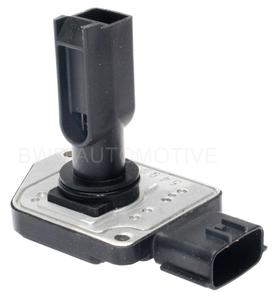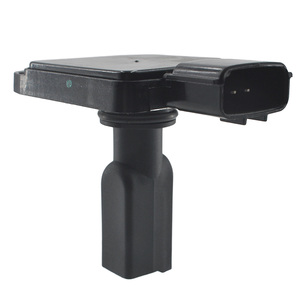Types of Ford Explorer Sensors
A Ford Explorer sensor refers to the numerous electronic components that monitor various aspects of the vehicle's operation. These sensors play a critical role in the vehicle's performance, safety, and overall functionality by providing real-time data to the vehicle's computer systems.
Engine Sensors
These sensors form the backbone of the engine management system, relaying vital information to the Engine Control Unit (ECU) for optimal performance:
- Mass Airflow Sensor (MAF): Measures air volume entering the engine to calculate proper fuel mixture
- Oxygen Sensor (O2): Monitors oxygen levels in exhaust gases to optimize combustion efficiency
- Crankshaft Position Sensor: Tracks crankshaft rotation speed for timing and fuel injection control
- Camshaft Position Sensor: Monitors camshaft position for precise valve timing
- Throttle Position Sensor (TPS): Tracks throttle valve position to monitor driver input
- Engine Coolant Temperature Sensor (ECT): Measures engine temperature for fuel and ignition timing adjustments
Transmission Sensors
These sensors communicate with the Transmission Control Module (TCM) to ensure smooth shifting and optimal transmission performance:
- Transmission Fluid Temperature Sensor: Monitors fluid temperature to prevent overheating
- Turbine Speed Sensor: Tracks transmission turbine speed for gear ratio control
- Transmission Range Sensor (TR): Identifies the selected gear position
- Transmission Pressure Sensor: Monitors hydraulic pressure to ensure proper clutch engagement
ABS Sensors
Anti-lock Braking System sensors prevent wheel lockup during emergency braking:
- Wheel Speed Sensors: Monitor individual wheel rotation speeds
- ABS Module: Processes wheel speed data to control brake pressure
These sensors allow the ABS to selectively adjust brake pressure at each wheel, maintaining steering control during emergency stops.
Occupant Detection Sensors
These safety-critical sensors adjust airbag deployment based on passenger presence and position:
- Seat Belt Tension Sensor: Detects if seatbelts are fastened
- Seat Position Sensor: Tracks seat location relative to airbags
- Weight Sensor: Determines passenger presence and approximate weight
Climate Control Sensors
These sensors help maintain cabin comfort by monitoring environmental conditions:
- Interior Temperature Sensor: Monitors cabin temperature
- Exterior Temperature Sensor: Tracks outside air temperature
- Sunload Sensor: Detects intensity of sunlight hitting the vehicle
The climate control system uses this data to automatically adjust temperature, fan speed, and air distribution for optimal comfort.
Expert Tip: Most modern Ford Explorer sensor issues will trigger a specific diagnostic trouble code (DTC) that can be read with an OBD-II scanner. This makes troubleshooting much more efficient than guessing which sensor might be malfunctioning.
Specifications and Maintenance of Ford Explorer Sensors
| Sensor Type | Technical Specifications | Maintenance Requirements |
|---|---|---|
| Oxygen Sensor (O2) | Voltage: 12V Thread Pitch: 18 Hex Design: 22 Position: Upstream Connector: Male |
Inspect every 60,000 miles Check for corrosion/damage Replace if showing delayed response |
| ABS Sensor | Frequency Tolerance: 1% Max Speed: 180 km/h Thread Size: M10 x 1.5 Mounting Hole: 3.6mm Mount Type: L-shaped bracket |
Inspect wiring for damage Clean sensor periodically Check mounting security |
| Mass Airflow Sensor | Voltage: 12V Thread Pitch: 18 Hex Design: 22 Position: Upstream Connector: Male |
Clean with MAF sensor cleaner only Inspect for contamination Check for proper airflow |
| Camshaft Position Sensor | Voltage: 5V Pins: 3 Frequency: 1-100 Hz Operating Temp: -40°C to 120°C Response Time: 1ms |
Inspect connections Check for oil contamination Test voltage output |
| Crankshaft Position Sensor | Voltage: 5V Pins: 3 Frequency: 1-100 Hz Operating Temp: -40°C to 120°C |
Inspect for debris/contamination Check wiring integrity Verify proper gap clearance |
Maintenance Best Practices
Regular Inspection: Check all sensor connectors for corrosion, damage, or looseness during routine maintenance intervals.
Wiring Examination: Inspect sensor wiring harnesses for cuts, abrasions, or heat damage, particularly near moving parts or hot surfaces.
Periodic Testing: Use a multimeter or OBD-II scanner to test sensor function and verify outputs are within specified ranges.
Quality Replacement: When replacement is necessary, use OEM or high-quality aftermarket sensors to ensure proper function and longevity.
Important: Always follow manufacturer's calibration procedures after replacing sensors. Some sensors require a "learning" or reset procedure to function properly with the vehicle's computer systems.
How to Choose Ford Explorer Sensors
Selecting the right sensors for your Ford Explorer requires careful consideration of several key factors. Making the right choice ensures optimal vehicle performance, fuel efficiency, and safety.
Compatibility Factors
- Vehicle Year and Model: Sensors are often specific to certain model years and engine configurations
- OEM vs. Aftermarket: Original equipment manufacturer parts ensure perfect compatibility but may cost more
- Engine Type: V6 and V8 engines often require different sensor specifications
Always verify part numbers and compatibility with your specific Explorer model before purchasing.
Quality Considerations
- Brand Reputation: Choose sensors from established manufacturers with proven reliability
- Warranty Coverage: Longer warranties often indicate manufacturer confidence in their product
- Material Quality: Look for corrosion-resistant materials for sensors exposed to elements
- Connector Design: Quality connectors with weather sealing prevent electrical issues
Expert Advice: For critical sensors like those in the engine management system, investing in higher quality OEM or premium aftermarket sensors often saves money in the long run by preventing performance issues and reducing the need for frequent replacements.
Selection Criteria by Sensor Type
| Sensor Type | Key Selection Criteria | Warning Signs of Poor Quality |
|---|---|---|
| Oxygen Sensor | Heating element quality, response time, material durability | Slow warm-up time, poor packaging, missing calibration data |
| Mass Airflow Sensor | Precision calibration, circuit board quality, housing seal | Loose components, poor electrical connections, no protective packaging |
| ABS Sensors | Signal clarity, resistance to contamination, cable quality | Thin wiring, loose mounting hardware, poor shielding |
| Camshaft/Crankshaft Sensors | Magnetic component quality, insulation, connector durability | Brittle plastic, poor molding quality, inconsistent dimensions |
Caution: Using counterfeit or extremely low-cost sensors can lead to inaccurate readings, triggering check engine lights, reduced fuel economy, and potential damage to other vehicle systems. The small upfront savings rarely justify the potential problems.
How to DIY and Replace Ford Explorer Sensors
Replacing sensors on your Ford Explorer can save time and money when done correctly. This guide will help you through the process safely and effectively.
Essential Tools for Sensor Replacement
- Diagnostic scan tool (OBD-II scanner)
- Digital multimeter for electrical testing
- Socket set and wrenches (including specialized oxygen sensor socket if applicable)
- Torque wrench for proper installation tightening
- Anti-seize compound (for threaded sensors)
- Electrical contact cleaner
- Service manual specific to your Explorer model
Step-by-Step Replacement Process
Diagnose the Problem: Use an OBD-II scanner to confirm which sensor is malfunctioning by reading trouble codes and viewing live data.
Prepare the Vehicle: Disconnect the battery negative terminal and allow the vehicle to cool completely if working with engine sensors.
Locate the Sensor: Refer to your service manual to find the exact location of the sensor needing replacement.
Disconnect the Electrical Connector: Press the release tab and carefully pull the connector straight out without twisting.
Remove the Old Sensor: Using the appropriate tool, carefully remove the sensor. For oxygen sensors, a specialized socket may be required.
Prepare the New Sensor: Compare the new sensor to the old one to ensure it's identical. Apply anti-seize compound to threads if recommended (but never on oxygen sensor threads).
Install the New Sensor: Insert the new sensor and tighten to the manufacturer's torque specification.
Reconnect the Electrical Connector: Ensure it clicks securely into place.
Reconnect the Battery: Reattach the negative battery terminal.
Clear Trouble Codes: Use your OBD-II scanner to clear any stored trouble codes.
Test Operation: Start the vehicle and verify the sensor is functioning properly using the scanner's live data function.
Pro Tip: Some sensors may require a "relearn" procedure after replacement. For example, after replacing a throttle position sensor, you might need to perform an idle relearn procedure. Check your specific model's service information for details.
Safety Warning: If you're replacing sensors in the exhaust system (like oxygen sensors), ensure the exhaust is completely cool before beginning work to avoid burns. Also, never work under a vehicle supported only by a jack - always use proper jack stands.
Frequently Asked Questions
Ford Explorer sensors are critical components that continuously monitor various vehicle systems and provide real-time data to the vehicle's computers. Their importance includes:
- Optimizing engine performance and fuel efficiency
- Enabling critical safety systems like ABS and airbags
- Providing early detection of developing problems
- Ensuring emissions compliance
- Managing comfort systems like climate control
Without properly functioning sensors, vehicle performance would degrade, safety systems might fail, and the check engine light would likely illuminate.
While modern Ford Explorer sensors are designed to be relatively durable, they can deteriorate or fail prematurely without proper maintenance. Common issues include:
- Oxygen sensors can become fouled by oil or contaminated fuel
- ABS sensors can be damaged by road debris or corroded by salt
- MAF sensors can become contaminated by dirt or oil particles
- Electrical connectors can corrode in humid environments
Regular inspection and maintenance help ensure sensors provide accurate readings throughout their expected service life, preventing poor performance and potentially expensive secondary damage.
Yes, sensor quality is extremely important for several reasons:
- Accuracy and Reliability: High-quality sensors provide consistent, accurate readings that allow vehicle systems to operate as designed
- Longevity: Premium sensors typically last longer, reducing the frequency of replacements
- System Compatibility: OEM or high-quality aftermarket sensors are calibrated specifically for your vehicle's systems
- Overall Cost: While quality sensors may cost more initially, they often provide better value by preventing repeat failures and protecting other vehicle components
Using low-quality sensors can lead to poor vehicle performance, reduced fuel economy, and potentially damaging conditions for other engine components.
Common symptoms of failing sensors include:
- Illuminated check engine light or other warning lights
- Rough idle or hesitation during acceleration
- Decreased fuel economy
- Unusual exhaust odor or color
- Hard starting or stalling
- Failed emissions test
- Erratic behavior from automatic transmission
The most reliable way to diagnose a sensor issue is to use an OBD-II scanner to check for trouble codes, which can specifically identify which sensor is having problems.



































































